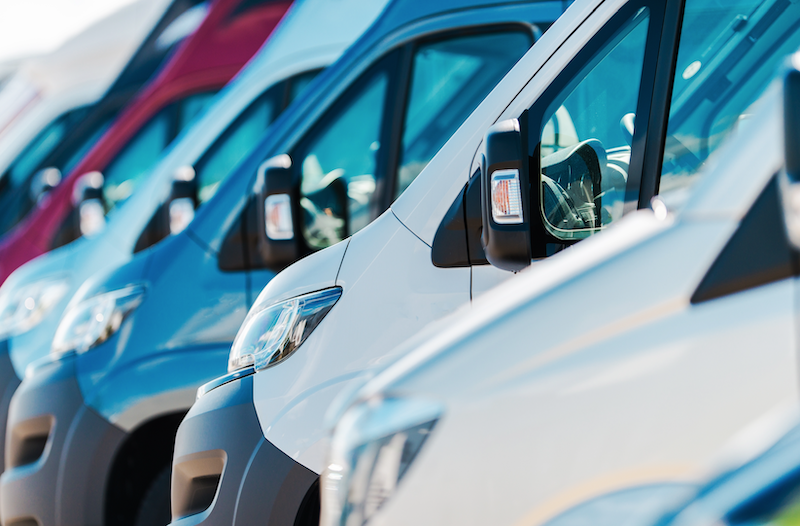Van Tax Relief: Beware vehicle classification of double-cab pick-ups and kombi vans
20th June 2020
!Updated Guidance – 2025 Tax Reform!
As of April 2025, HMRC revised the criteria for how double cab pick-ups and combi vans are classified for tax purposes. Most are now classed as cars rather than vans, unless strict construction-based tests are passed. If you haven’t reviewed your fleet since these changes took effect, your business could now face significantly higher tax liabilities.
Click here to read our up-to-date 2025 guidance on vehicle classification and how to stay compliant 2025 Guidance
Double-cab (kombi) van and double-cab pick-up vehicles types are on the rise, thanks to their practical size for daily business but with the looks, style and functionality to act as the family car on weekends. Their added benefit is the ability to also claim van tax relief typically associated with vans. Their exact vehicle classification in the eyes of HMRC should however be treated with caution to ensure that you are not claiming reliefs in the instance where your vehicle is actually a car. This guide highlights the potential van tax relief available and the vehicle definitions you should be aware of when using or owning a double-cab (kombi) van or pick-up.
Traditional van tax relief
Driving a company van can be an attractive option as there are a number of associated tax reliefs;
Benefit-in-Kind Relief
Company cars are subject to a sliding scale tax model, usually worked out on the basis of their P11D price (initial list price, including VAT/taxes but minus road tax and registration fee)* multiplied by their Bik tax band (based on CO2 emissions rate) before being multiplied by the individual taxpayer’s rate of tax to give an annual total.
Example VW Passat EstateDiesel – 1598cc (1.6 litre)1.6 TDI SE 120PS DSG – Semi-automatic 7-speed**
- P11D rate: £29,610
- CO2 g/km: 158
- BiK Rate (based on CO2 emissions): 37%
- BiK Rate multiplied by P11D rate: £10,955.70
- 20% tax rate multiplied by Bik Rate: £2,191.14 BiK final tax calculation
Vans are treated differently, being taxed at a fixed BiK rate dependent on their usage. HMRC has certain definitions of usage that it uses to classify vans for tax purposes:
- The first definition of usage is classed by HMRC as “insignificant private use”. This is when the van is used pretty much solely for work/commuting and therefore has no Benefit-in-Kind (BiK) to the employee and therefore no individual tax to pay. There is a clearly outlined list from HMRC in Section 114(3A) ITEPA 2003, defining what classes as insignificant use but a good rule of thumb is looking at no more than a few days of irregular usage maximum over the tax year or simple “stop-offs” on the way to and from work.
- ‘Significant private usage‘ is the other HMRC van usage category to be aware of and the definition stipulated means that usage can quickly mount up to “significant” in the eyes of the government, resulting in the driver having to pay BiK company van tax. Even shopping trips, heading out to the cinema or dropping kids off at football regularly can move van usage into this category. Again, HMRC gives lots of examples of significant private usage.
The good news is that, even if the van usage does not qualify for “insignificant private use”, the BiK rate for vans can often still be lower than that of many comparable company cars as the BiK rate for vans is at a fixed rate, rather than the sliding scale applied to cars.
To work out how much company van tax you will pay, you must take the fixed van BiK value for that year (2020/2021 = £3,490 ) and then multiply that amount by the rate of tax you pay (typically either 20% or 40%)
To see how this can work out favourably for a van driver, compare the BiK tax rate of this Volkswagen Transporter (classing as a van) to that of some other possible company vehicles with higher than average car capacity.**
| Model/Make | CO2 g/km | BiK % tax band | 2020/21 Cost per year (20% taxpayer) | 2020/21 Cost per year (40% taxpayer) | |
| BMW X4 Diesel – 1995cc (2 litre)xDrive20d M Sport Auto – Automatic 6-speed | 168 | 37% | £3,507 | £7,014 | |
|
Mercedes-Benz Sprinter New 411 CDI 4.1t L1 H1 FWD |
208 | Flat rate | £698 | £1,396 | |
| Nissan X-Trail Diesel – 1749cc (1.7 litre)1.7 dCi 150 Acenta – Manual 6-speed | 156 | 37% | £2,014 | £4,027 | |
| VW Passat Estate Diesel – 1598cc (1.6 litre)1.6 TDI SE 120PS DSG – Semi-automatic 7-speed | 158 | 37% | £2,191 | £4,382 |
If an employer pays for private fuel for an employee then this is classed as a further BiK. The exact amount paid by an individual taxpayer is calculated in a similar way as the BiK car tax rate. The vehicle BiK % tax band (based again on the P11D value multiplied by the on CO2 emissions) is multiplied by the BiK fuel benefit rate for that year (£24,500 for 2020/2021) before being multiplied by the individual taxpayer’s rate of tax.
For vans the BiK fuel benefit rate is fixed. For 2020/2021 this is set at £666. This total is simply multiplied by the individual taxpayer’s rate of tax. Again, this can give considerable vehicle tax breaks to van drivers as seen in the example below. **
| Model/Make | CO2g/km | BiK tax band | BiK to pay at 20% rate of tax | BiK to pay at 40% rate of tax |
| Nissan X-Trail Diesel – 1749cc (1.7 litre)1.7 dCi 150 Acenta – Manual 6-speed | 156 | 37% of £24,500 | £1,813 | £3,626 |
|
Mercedes-Benz Sprinter New 411 CDI 4.1t L1 H1 FWD |
208 | Flat Rate £666 | £133.20 | £266.40 |
Capital Allowance Relief
The purchases of vans/LCVs also qualify for Annual Investment Allowance, giving up to 100% relief of cost in the first year of purchase.
Company cars however only qualify for Writing Down Allowance, giving relief of 18% (6% if Special Rate) in the first year and then the remainder pooled over subsequent years. A car may also qualify for First Year Allowances depending on vehicle type (electric/fuel) and its emissions.
If claiming any reliefs related to vans then you must ensure that the vehicle you have bought does not classify as a car within the car definitions of HMRC.
Leased vehicles are treated differently and other vehicle expenses are calculated depending on individual circumstances – such as whether you are self-employerd or a limited company. You should always seek professional advice with regards to any tax adjustments or expense claims.
VAT Relief
If a business is registered for VAT then it is able to claim the VAT back on the cost of a company vehicle, provided that there is a valid VAT invoice and the vehicle is being used for business purposes only. There are specific definitions of a van for the purposes of VAT from HMRC that should be referenced that differ slightly from the PMA definitions.
Vehicle Excise Duty (VED) Relief
A car VED (commonly known as road tax) is based on its emissions, whereas van road tax (VED) is set at a fixed rate, dependent on how old it is (Euro 4, Euro 5 or LGV classification). These rates for a comparable engine size within a car are often much more favourable for a van.

HMRC Vehicle Classification
Kombi vans such as the VW Transporter and double-cab pick-ups such as the VW Amarok or Nissan Navara are growing in popularity as a vehicle choice. Modern-day car luxuries are increasingly incorporated as standard, meaning these wheels can give the same feel of a “new car” but with the practicality of a commercial vehicle. Added to this is the potential van tax relief that come with owning a van or LCV. The actual classification of these vehicles for tax purposes can be a bit of a grey area however, so it’s important to be fully aware of the legislation in this area.
Definition of a “Van”
For the purposes of Capital Allowance and BiK claims, for your vehicle to class as a van/LCV then we can look at following definitions laid out in Section 115 of the IETPA 2003 from HMRC Employment Income Manual:
“In deciding whether or not a particular vehicle counts as a car for car benefits purposes, the starting point is the definition in Section 115(1) Income Tax (Earnings and Pensions) Act 2003 (ITEPA). This works by exception: every mechanically propelled road vehicle is a “car” unless it is
-
-
(i) a goods vehicle (a vehicle of a construction primarily suited for the conveyance of goods or burden of any description),
-
(ii) a motor cycle (as defined in Section 185 Road Traffic Act 1988),
-
(iii) an invalid carriage (also as defined in that Act), or
-
(iv) a vehicle of a type not commonly used as a private vehicle and unsuitable to be so used.”
-
For a vehicle to be defined as a van, we typically look at section 1 of this definition; “a vehicle of a construction primarily suited for the conveyance of goods or burden of any description”
The guidance states that it is not the actual use of the vehicle that should be taken into consideration, rather the original way in which it was constructed for its intended use. When considering the classification of your vehicle, consider the following statement within the guidance;
“It is only if the primary purpose for which the vehicle is constructed is the carriage of goods that it will escape from being a car…If a vehicle has side windows behind the driver and passenger doors, it is also unlikely to fall within this exception. This is particularly so if it is fitted, or is capable of being fitted, with additional seating behind the row which includes the driver. This remains true whether or not those additional seats are in the vehicle at the time.“
Impact on classification of double-cab Kombi vans and pick-ups
This places some ambiguity around the classification of “kombi” vehicles such as kombi vans and double-cab pick-ups and their tax implications if they are not solely for business use. The addition of the second row of seats throws up the question of whether the vehicle is primarily for the carriage of passengers or the conveyance of goods? Guidance specifically states that if the vehicle is marketed as “multipurpose” then it probably does not classify as a van. The same applies if there is an additional row of seats and/or windows behind the driver/passenger row.
Double-cab pick-ups
In the case of double-cab pick-ups, government has clarified the situation with specific guidance that relies on the payload of the vehicle to dictate whether it should be classed as car or van.
“a double cab pick-up that has a payload*** of 1 tonne (1,000kg) or more is accepted as a van for benefits purposes.”
In this instance, bear in mind that vehicle modifications that change the weight of the vehicle (including pick-up hard tops classed as a generic 45kg for this purpose) need to be checked to ensure that the payload has not been impacted.
Kombi Vans
In the case of kombi vans, this has historically been a little more ambiguous. Indeed, government’s own guidance in this area is a little grey and outdated. (View this list of car-derived vans and kombi vehicles from 2015.) However, in 2019 an upper tribunal appeal upheld a first tribunal appeal decision that a Volkswagen Kombi Transporter T5 would class as a car for tax and benefits purposes. Coca Cola had argued that this vehicle type, which it supplied to its employees, should be classed as a van, particularly given that the second row of seats could be removed. It lost the appeal and, given that this was an upper tribunal decision, the case will now set a precedent for future law. Confusingly, within the same case, it was decided at first appeal that a Vauxhall Vivaro (also with a payload of over one tonne and with a second row of seats fitted but, importantly, not to full width of the vehicle, giving more cargo space) did, in fact, class as a van. This throws up further ambiguity for kombi van owners.
How do I know if my pick-up or kombi van classes as a van?
Our advice would always be to proceed with caution in this area. Seek advice first from your vehicle manufacturer as to their detailed classification and payload of your vehicle for tax purposes. Just because you are purchasing something with a payload of over one tonne, advertised as a commercial or multi-purpose vehicle, does not mean that it will class as a van in the eyes of HMRC. This could have huge financial implications for the total tax that you pay.
You should also consult with your professional accountant and/or HMRC directly to ask their advice about a particular model and usage.
Very important to note is that the classification of a van differs for both Vehicle Excise Duty and VAT legislation compared to income tax benefits. Ensure that you and your advistors have done your due diligence in all of these areas for tax compliance and efficiency.
How we can help
Our team at TTR Barnes has extensive experience in vehicle classification and associated van tax relief. If you would like to understand more, please do not hesitate to contact us.






